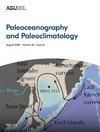Estimating Plio‐Pleistocene North African Monsoon Runoff Into the Mediterranean Sea and Temperature Impacts
IF 3.2
2区 地球科学
Q2 GEOSCIENCES, MULTIDISCIPLINARY
引用次数: 0
Abstract
Abstract Sapropels are dark, organic‐rich layers found in Mediterranean sediments that formed during periods of bottom water anoxia. While various mechanisms have been proposed to have caused anoxic conditions, a primary factor is considered to be water column stratification induced by freshwater runoff related to intensified North African monsoon precipitation during precession minima. Monsoon intensification also induced Green Sahara Periods that may have impacted North African hominin dispersal. In this study, we present a novel regression‐based deconvolution of a high‐resolution planktonic foraminiferal oxygen isotope record to estimate the combination of freshwater runoff reaching the eastern Mediterranean and associated surface warming of the water column over the past 5 million years. Sapropels are known to occur in clusters associated with periods of high orbital eccentricity. Our analysis reveals a consistent influence of orbital eccentricity in modulating the North African monsoon, and a possible shift in runoff source area induced by the initiation of Northern Hemisphere ice sheets. Our findings provide important insights into the role of the North African monsoon in shaping Mediterranean environmental changes over the past 5 million years.估计上新世-更新世北非季风径流进入地中海和温度影响
腐膜是在地中海沉积物中发现的深色、富含有机物的层,形成于海底缺氧时期。虽然已经提出了各种导致缺氧条件的机制,但一个主要因素被认为是与进动极小期北非季风降水加剧有关的淡水径流引起的水柱分层。季风的增强也导致了绿色撒哈拉时期,这可能影响了北非人类的扩散。在这项研究中,我们提出了一种新的基于回归的高分辨率浮游有孔虫氧同位素记录的反褶积,以估计在过去500万年中到达地中海东部的淡水径流和相关的水柱表面变暖的组合。我们知道,星轮出现在与高轨道离心率周期相关的星团中。我们的分析揭示了轨道偏心率对北非季风的持续影响,以及北半球冰盖的形成可能导致径流源区的转移。我们的发现为了解北非季风在过去500万年中塑造地中海环境变化的作用提供了重要的见解。
本文章由计算机程序翻译,如有差异,请以英文原文为准。
求助全文
约1分钟内获得全文
求助全文
来源期刊

Paleoceanography and Paleoclimatology
Earth and Planetary Sciences-Atmospheric Science
CiteScore
6.20
自引率
11.40%
发文量
107
期刊介绍:
Paleoceanography and Paleoclimatology (PALO) publishes papers dealing with records of past environments, biota and climate. Understanding of the Earth system as it was in the past requires the employment of a wide range of approaches including marine and lacustrine sedimentology and speleothems; ice sheet formation and flow; stable isotope, trace element, and organic geochemistry; paleontology and molecular paleontology; evolutionary processes; mineralization in organisms; understanding tree-ring formation; seismic stratigraphy; physical, chemical, and biological oceanography; geochemical, climate and earth system modeling, and many others. The scope of this journal is regional to global, rather than local, and includes studies of any geologic age (Precambrian to Quaternary, including modern analogs). Within this framework, papers on the following topics are to be included: chronology, stratigraphy (where relevant to correlation of paleoceanographic events), paleoreconstructions, paleoceanographic modeling, paleocirculation (deep, intermediate, and shallow), paleoclimatology (e.g., paleowinds and cryosphere history), global sediment and geochemical cycles, anoxia, sea level changes and effects, relations between biotic evolution and paleoceanography, biotic crises, paleobiology (e.g., ecology of “microfossils” used in paleoceanography), techniques and approaches in paleoceanographic inferences, and modern paleoceanographic analogs, and quantitative and integrative analysis of coupled ocean-atmosphere-biosphere processes. Paleoceanographic and Paleoclimate studies enable us to use the past in order to gain information on possible future climatic and biotic developments: the past is the key to the future, just as much and maybe more than the present is the key to the past.
 求助内容:
求助内容: 应助结果提醒方式:
应助结果提醒方式:


